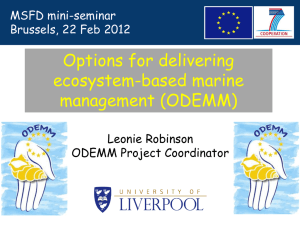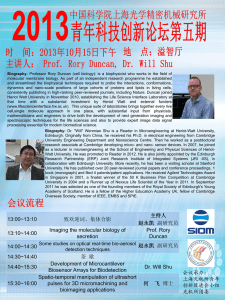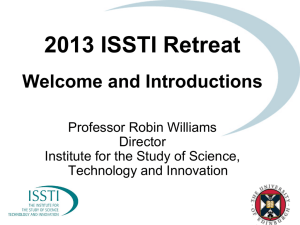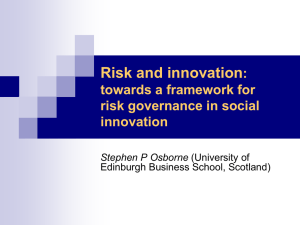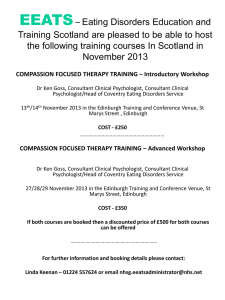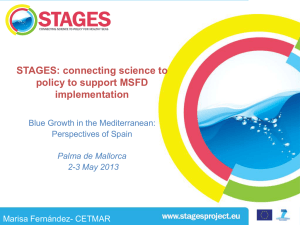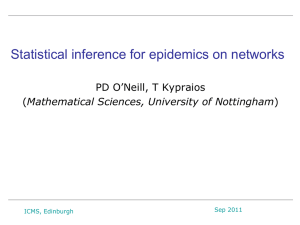Leonie_ODEMM
advertisement
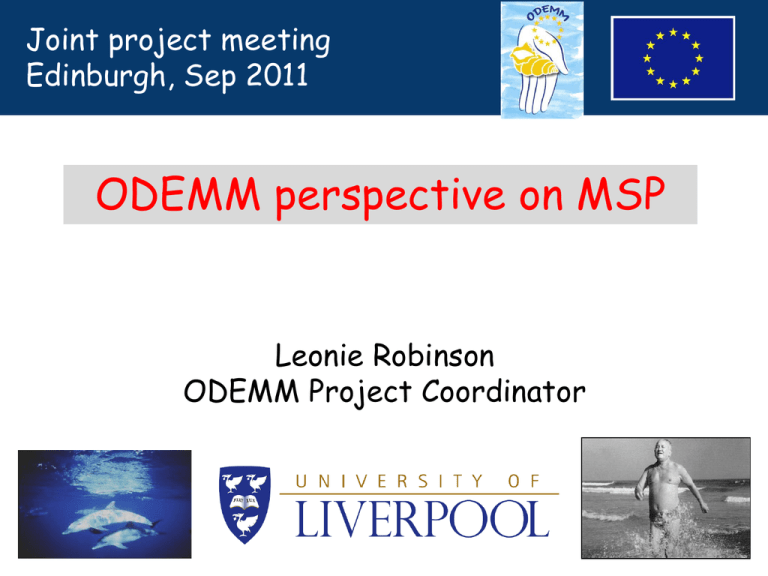
Joint project meeting Edinburgh, Sep 2011 ODEMM perspective on MSP Leonie Robinson ODEMM Project Coordinator Joint project meeting Edinburgh, Sep 2011 March 2010 - August 2013 • Options for Delivering Ecosystem-based Marine Management (ODEMM) AIM: To develop a set of fully-costed ecosystem management options that would deliver the objectives of the Marine Strategy Framework Directive, the Habitats Directive, the European Commission Blue Book and the Guidelines for the Integrated Approach to Maritime Policy. Joint project meeting Edinburgh, Sep 2011 EU Marine Strategy Framework Directive • Goal – to achieve GES in Europe’s seas by 2020 • ODEMM’s management options must be coherent with the MSFD in terms of objectives, implementation and governance. Joint project meeting Edinburgh, Sep 2011 Timeline for MSFD taken from UK perspective (DEFRA) ODEMM We are coming up with tools, knowledge and strategies that will help to implement the MSFD (novel work)..... Joint project meeting Edinburgh, Sep 2011 MSFD Descriptors D1: Biological diversity is maintained. The quality and occurrence of habitats and the distribution and abundance of species are in line with prevailing physiographic, geographic and climatic conditions. D2: Non-indigenous species introduced by human activities are at levels that do not adversely alter the ecosystems. D3: Populations of all commercially exploited fish and shellfish are within safe biological limits, exhibiting a population age and size distribution that is indicative of a healthy stock. D4: All elements of the marine food webs, to the extent that they are known, occur at normal abundance and diversity and levels capable of ensuring the long-term abundance of the species and the retention of their full reproductive capacity. Joint project meeting Edinburgh, Sep 2011 MSFD Descriptors D5: Human-induced eutrophication is minimised, especially adverse effects thereof, such as losses in biodiversity, ecosystem degradation, harmful algae blooms and oxygen deficiency in bottom waters. D6: Sea-floor integrity is at a level that ensures that the structure and functions of the ecosystems are safeguarded and benthic ecosystems, in particular, are not adversely affected. D7: Hydrographical conditions.., D8: Contaminants in the environment, D9: Contaminants in seafood, D10: Marine Litter, D11: Underwater noise A mixture of state and pressure-based descriptors Joint project meeting Edinburgh, Sep 2011 ODEMM perspective on MSP? 1. Will management measures relevant to all descriptors have a spatial context? 2. Can MSP be a useful tool to try and select for management measures that ensure multiple gains (across descriptors) on GES within particular areas? Joint project meeting Edinburgh, Sep 2011 Space and boundaries for the MSFD • Four marine regions • Member States sharing a region obliged to cooperate so that objectives can be achieved at the regional scale; must be coherent and coordinated regionally • Reality – MSs implementing for their sea areas with some regional cooperation through regional sea conventions and/or the commission’s working groups Joint project meeting Edinburgh, Sep 2011 Marine Regions Baltic Sea Mediterranean Sea North East Atlantic Ocean EEZ Boundaries Marine Sub-regions Atlantic Ocean Bay of Biscay & Iberian Coast Celtic Sea Greater north Sea Adriatic Sea Aegean-Levantine Sea Ionian Sea W. Mediterranean Sea Joint project meeting Edinburgh, Sep 2011 ODEMM perspective on MSP? 1. Will management measures relevant to all descriptors have a spatial context? 2. Can MSP be a useful tool to try and ensure multiple gains on GES within particular areas? 3. Given the commitment to cooperate regionally, but the reality of initial progress being MS driven, can MSP contribute in viewing overall regional problems and gains from the combined efforts of implementing measures? Joint project meeting Edinburgh, Sep 2011 ODEMM Case study areas – not yet fully defined but ... 2 1 4 3 Joint project meeting Edinburgh, Sep 2011 Objective 1: To provide a comprehensive knowledge base to support policy for the development of sustainable and integrated management of European marine ecosystems. (Ds 1-4)[WPs 1 & 2] • WPs 1 and 2 complete • WP 1 Outputs: Technical report (D1) and tools – linkage framework, pressure assessment, metadata database, summary of threats relevant to GES in all regional seas • WP2 Outputs: 3 journal articles – legal, institutional and sectoral perspectives on implementation of MSFD (and EA) Joint project meeting Edinburgh, Sep 2011 Objective 2: To develop Operational Objectives to achieve the High-Level Policy Objectives set by the Marine Strategy Framework Directive and the Habitats Directive, and with reference to the proposed Maritime Policy. (Ds 5-6) [WP 3] • WP3 complete • WP3 Outputs: Review of HLOs relevant to the MSFD and across regional seas, Risk assessment methodology for match of current status to GES (applied to all regional seas), Review of available operational objectives for high threat HLOs Summaries for each GES descriptor in each regional sea plus all background information (D1, Annexes 1-4) ODEMM tools: linkage framework Joint project meeting Edinburgh, Sep 2011 ODEMM perspective on MSP? 1. Will management measures relevant to all descriptors have a spatial context? 2. Can MSP be a useful tool to try and ensure multiple gains on GES within particular areas? 3. Given the commitment to cooperate regionally, but the reality of initial progress being MS driven, can MSP contribute in viewing overall regional problems and gains from the combined efforts of implementing measures? 4. Tools developed in WPs 1 and 3 can all be applied within the context of MSP (e.g. Pressure assessment, risk assessment) 5. Knowledge gained from WP 2 reveals governance reality in terms of potential for implementing MSFD (some spatial issues) Joint project meeting Edinburgh, Sep 2011 st reporting period Del no. WP Deliverables 1Name Status 1 1 Tech report: Status of regional seas re. Sustainability Complete 2 2 Journal article: European law/policy Published 3 2 Journal article: positions on EA and policy process towards MSFD Submitted 4 2 Journal article: implications different perspectives on implementing MSFD and EA Submitted 5 3 Journal article: HLOs, methodology for assessing and results using regional seas In prep 6 3 Tech report: regional reporting on potential operational objectives for failing HLOs Complete 18 9 Project website Online 20 11/12 1st Interim report Aug 2011 Joint project meeting Edinburgh, Sep 2011 Objective 3: To identify Management Options (individual management tools and combinations of tools) to meet the Operational Objectives. (Ds 7-8) [WP 4] • Identify human activities most likely to compromise meeting operational objectives • Develop and formally evaluate a range of management strategies or options for these activities using different types of measures and tools • Consider the resources required in terms of infrastructure and governance to enforce the management strategies evaluated Joint project meeting Edinburgh, Sep 2011 Objective 4: To provide a risk assessment framework for the evaluation of Management Options and to assess the risk associated with the different options. (Ds 9-10) [WP 5] • Identification of different sources of risk to meeting operational objectives • Design of a risk assessment framework able to deal with a range of risk types • Application of risk assessment for a selection of operational objectives in each (sub) region under different scenarios (management strategies from WP4 contrasted with do-nothing scenarios) Joint project meeting Edinburgh, Sep 2011 Objective 5: To conduct a cost-benefit analysis of a range of Management Options using appropriate techniques. (Ds 1112) [WP 6] • Measure the cost of policy inaction (COPI) in the four study regions, in terms of deterioration in provision of ecosystem goods and services (EGSs) • Estimate the costs and monetary benefits of each specified management option, measured in terms of change in provision of EGSs relative to do-nothing scenario • Produce a web-based tool allowing users to juxtapose costs and benefits of different management options and actions Joint project meeting Edinburgh, Sep 2011 Objective 6: ID stakeholder opinions on creation of governance structures directed towards implementation of the EA and to elaborate different scenarios for changing governance structures and legislation to facilitate a gradual transition from the current fragmented management approach towards fully integrated ecosystem management. (Ds 13-15) [WP 7] • Stakeholder consultation on governance structures required to implement sorts of management scenarios • Investigate legal constraints and opportunities to improving implementation at EU and regional level • Elaborate and consult on different scenarios for changing governance structures and legislation where required Joint project meeting Edinburgh, Sep 2011 Objective 7: To document the steps necessary for the transition from the current fragmented management scheme to a mature and integrated approach, and to provide a toolkit that could be used to evaluate options for delivering ecosystem-based management. (Ds 16-17) [WP 8] • ID social, economic, ecological and institutional obstacles to achieving objectives in an EA • Produce an accessible guide to the toolkit of techniques required to evaluate options and actions • Produce an Implementation Plan for the steps required to achieve the transition to an integrated EA
